Glossary of road transport terms

Terminology related to road transport—the transport of passengers or goods on paved (or otherwise improved) routes between places—is diverse, with variation between dialects of English. There may also be regional differences within a single country, and some terms differ based on the side of the road traffic drives on. This glossary is an alphabetical listing of road transport terms.
0–9
- 2+1 road
- A specific category of three-lane road, consisting of two lanes in one direction and one lane in the other, alternating every few kilometres, and separated usually with a steel cable barrier.
- 2+2 road
- A specific type of dual carriageway being built in Ireland, Sweden, and Finland, consisting of two lanes in each direction separated by a steel cable barrier.
- 3-way junction or 3-way intersection
- 5-1-1
- A transportation and traffic information telephone hotline in some regions of the United States and Canada that was initially designated for road weather information.
A
- Access road
See frontage road
- Alternate route or optional route
- A highway that splits off the mainline and reconnects some distance later.
- At-grade intersection
- A junction at which two or more roads cross at the same level or grade.
- Annual average daily traffic (AADT)
- A measure of total volume of vehicle traffic on a segment of road for a year divided by 365 days to produce an average.
- Arterial road or arterial thoroughfare
- A high-capacity urban road designed to deliver traffic at the highest possible level of service.
- Auxiliary route
- A highway that supplements a major or mainline highway.
B
- Barrier toll system or open toll system
- A method of collecting tolls on highways using toll barriers at regularly spaced intervals on the toll road's mainline, usually charging a flat rate at each barrier.
- Beltway
See ring road
- Box junction
- A road traffic control measure designed to prevent congestion and gridlock at junctions. The surface of the junction is typically marked with a criss-cross grid of diagonal painted lines (or only two lines crossing each other in the box), and vehicles may not enter the area so marked unless their exit from the junction is clear (or, if turning, to await a gap in the oncoming traffic flow).
- Bus lane
- A lane restricted to buses, and sometimes certain other vehicles such as taxis.
- Business route or city route
- An auxiliary route that passes through the central business district of a city.
- Butterfly junction
- Bypass
- An auxiliary route that relieves congestion along the mainline by routing traffic around a city or congested area. Can also be used to refer to a segment of road built to reroute the mainline away from a city or congested area.
C
- Cant or camber
- The gradient of the road surface at 90° to the direction of travel; the difference in height between the edge and the crown of the road.
- Carriageway
- A width of road on which a vehicle is not restricted by any physical barriers or separation to move laterally. A roadway can comprise one or more carriageways; single carriageways may contain both directions of traffic for the roadway, while multiple carriageways can separate traffic by direction or type.
- Cat's eye
- A retroreflective safety device used in road marking and the first of a range of raised pavement markers.
- Central reservation
See median strip
- Circumferential highway
See ring road
- City route
See business route
- Closed toll collection system
See ticket system
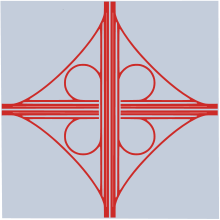
- Cloverleaf interchange or cloverleaf junction
- A two-level interchange in which turns are handled by eight total ramp or slip roads, four of which form loops that give the interchange the shape of a cloverleaf from the air. Each ramp allows traffic from one direction of a roadway to access only one direction of the crossroad: e.g. from northbound to eastbound while a separate ramp connects from northbound to westbound. Traffic is fully grade separated; it does not need to stop to make any of the connections between the two roadways.
- Coastal evacuation route
- Collector–distributor lanes
- Concurrency
- An instance of one physical road bearing two or more different highway, motorway, or other route numbers.
- Connector or cutoff
- An auxiliary route that provides a shortcut between two routes or a connection between two routes that otherwise do no connect.
- Constitutional route
- A highway defined in the constitution of the place in which it is located. Only found in Minnesota.
- Continuous-flow intersection, CFI, crossover displaced left-turn, XDL, or DLT
- An intersection where vehicles attempting to turn across the opposing direction of traffic (left in right-hand drive jurisdictions; right in left-hand drive jurisdictions) cross before they enter the intersection. No left turn signal in the intersection is then necessary.
- Continuous green T-intersection
- Contraflow lane reversal
- The reversal of direction of traffic in a lane, to facilitate emergency evacuations, roadworks, or events.
- Controlled-access highway, motorway, or freeway
- A type of highway which has been designed for high-speed vehicular traffic, with all traffic flow and ingress/egress regulated.
- The corduroy
See rumble strips
- County highway, county road, or county route
- A road in the United States and in the Canadian province of Ontario that is designated and/or maintained by the county highway department.
- Couplet
See one-way pair
- Crosswalk
- Cul-de-sac, dead end, closed, no through road, no exit, court, or no outlet
- A street with only one inlet/outlet.
D
- Dead end
See cul-de-sac
- Decommissioned highway
- A former highway which was removed from the highway system is said to be decommissioned. The term also applies to a designation which was removed from a highway system, such as when the U.S. Route 66 was removed from the United States Numbered Highway System in 1985. The physical roadbed typically remains usable, and it may then receive a different designation as another classification of road.[1][2]

- Diamond interchange
- An interchange between a freeway and a minor road where the off-ramp diverges only slightly from the freeway and runs directly across the minor road at an at-grade intersection, becoming an on-ramp that returns to the freeway in similar fashion.
- Directional interchange
- Diverging diamond interchange, DDI, double crossover diamond interchange, or DCD
- A type of diamond interchange in which the two directions of traffic on the non-freeway road cross to the opposite side on both sides of the bridge at the freeway.
- DLT
- Dual carriageway or divided highway
- A class of highway with two carriageways for traffic traveling in opposite directions separated by a median strip or central reservation.
- Drivers' working hours
- Regulations that govern the activities of commercial truck drivers, most notably limiting the number of hours a person may drive during the day or week.
- Dynamic message sign
E
- Electronic toll collection
- A system of toll collection where a driver attaches a transponder to his or her vehicle or where a camera recognizes the vehicle registration plates. Tolls are charged automatically to the driver, either by prepaid account or by regular billing, when the vehicle passes through a toll booth or gantry.
- Escape lane or emergency escape ramp
- Evacuation route
- Exit number
- A number assigned to a road junction, usually an exit from a freeway.
- Expressway
F
- Farm-to-market road, ranch-to-market road, farm road, or ranch road
- A highway that connects rural or agricultural areas to market towns.
- Freeway
- Frontage road, access road, service road, or parallel road
- A local road running parallel to a higher-speed, limited-access road.
.jpg)
- Floodway
- A flood plain crossing built at or close to the natural ground level,[3] designed to be submerged under water, but withstand such conditions—typically used when flood frequency or time span is minimal, traffic volumes are low, and the cost of a bridge is uneconomic.[4]
- Footpath or footway
See sidewalk
G
- Ghost island
See traffic island
- Gore, gore point, gore zone, or merge nose
- A triangular piece of land found where roads merge or split.
- Grade, slope, incline, gradient, pitch or rise
- The degree by which a road rises or declines, affected by fills and cuts designed and built to reduce the steepness of a road.
- Grade separation
- The method of aligning a junction of two or more road axes at different heights (grades) so that they will not disrupt the traffic flow on other transit routes when they cross each other.
- Growlers
See rumble strips
- Guard rail, guardrail, guide rail, or railing
- A system designed to keep people or vehicles from (in most cases unintentionally) straying into dangerous or off-limits areas.
H
- Hairpin turn, hairpin bend, hairpin corner, or hairpin curve
- A bend in a road with a very acute inner angle that resembles a hairpin/bobby pin, making it necessary for an oncoming vehicle to turn almost 180° to continue on the road.
- Haulage
- The business of transporting goods by road or rail.
- High-occupancy vehicle lane or HOV lane
- A lane reserved for vehicles carrying two or more passengers or other exempted vehicles.
- High-occupancy toll lane or HOT lane
- An HOV lane that charges a toll for vehicles that do not meet HOV regulations.
- High-T intersection
- Highway
- Any public road or other public way on land. It is used for major roads, but also includes other public roads and public tracks.
- Highway shield or route marker
- A graphical representation of a route number, which serves as navigational aid
- Holiday route
See scenic route
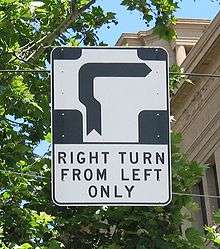
- Hook turn
- A right turn made from the left lane (countries that drive on the left), or a left turn made from the right lane (countries that drive on the right).
- Hurricane evacuation route, coastal evacuation route, or evacuation route
- A highway in the United States that is a specified route for hurricane evacuation.
I
- Incline
See grade

- Interchange
- A road junction that typically uses grade separation, and one or more ramps, to permit traffic on at least one highway to pass through the junction without directly crossing any other traffic stream.
- Intersection
- An at-grade road junction of two or more roads either meeting or crossing.
J
- Jersey barrier, Jersey wall, K-rail, or Ontario tall wall
- A modular concrete or plastic barrier employed to separate lanes of traffic.

- J-turn
See superstreet
- Jughandle or Jersey left
- A type of ramp or slip road where instead of a standard left turn being made from the left lane, left-turning traffic uses a ramp on the right side of the road (in countries that drive on the right).
- Junction
- A location where multiple roads intersect, allowing vehicular traffic to change from one road to another.
K
- K-rail
See Jersey barrier
- K-turn
See three-point turn
L
- Land train
See road train
- Lane
- Part of a carriageway or roadway that is designated for use by a single line of vehicles, to control and guide drivers and reduce traffic conflicts.[5]
- Legislative route
- A highway defined by laws passed in a legislature. The numbering of such highways may or may not correspond to the numbers familiar to the posted route number.
- Left-in/left-out (LILO)
- Level of service
- A measurement used to describe the quality of traffic on a highway. Levels range from free flowing traffic to constant traffic jams.
- Limited-access road or expressway
- A highway or arterial road for high-speed traffic which has many or most characteristics of a controlled-access highway, including limited or no access to adjacent property, some degree of separation of opposing traffic flow, use of grade separated interchanges to some extent, prohibition of some modes of transport such as bicycles or horses and very few or no intersecting cross-streets. The definitions and degrees of isolation from local traffic allowed varies between countries and regions.[6]
- Local-express lanes or collector–distributor lanes
- An arrangement of roadways within a major highway where long distance traffic can use lanes with fewer interchanges compared to local traffic which use 'local' or 'collector' lanes that have access to all interchanges.
- Loop Around
See Texas U-turn
- Lorry
See truck
- Lorry driver
See truck driver
M
- MUTCD signs
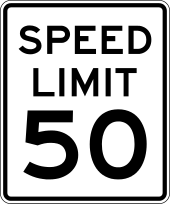 Speed limit
Speed limit No parking
No parking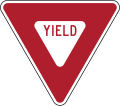 Yield (Give Way)
Yield (Give Way) Round-about
Round-about
- Manual of Uniform Traffic Control Devices
- A manual published by the Federal Highway Administration in the United States, or similar manuals published by state departments of transportation, that specifies the standards for traffic signs, highway markings, and traffic signals (collectively "traffic control devices"). The manual includes specifications on typefaces, colors, and shapes of signs, as well as placement of these traffic control devices.
- Matrix sign
- Median strip or central reservation
- The reserved area that separates opposing lanes of traffic on divided roadways. The reserved area may simply be paved or grass, but can be adapted to other functions, such as decorative landscaping, trees, a median barrier, or railway or streetcar lines.
- Merge
- The process of reducing the number of lanes available to traffic, commonly from two lanes to one.
- Merge nose
See gore
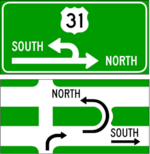
- Michigan left
- An at-grade intersection design which replaces each left turn with a right turn followed by a U-turn, or a U-turn followed by a right turn
- Milestone, mile markers, mileposts or mile post
- One of a series of numbered markers placed along a road or boundary at intervals of one mile or occasionally, parts of a mile.
- Motorway
N
- National highway
- A road numbered consistently throughout a country. Maintenance of the road may be performed at the national level or it may be devolved to states or provinces or to lower levels of administration. The Interstate Highway System, Trans-Canada Highway, and German autobahns are examples of national highways.
- No through road, no exit, or no outlet
See cul-de-sac
O
- One-way pair, one-way couple, or couplet
- A pair of parallel, usually one-way streets that carry opposite directions of traffic.
- Ontario tall wall
See Jersey barrier
- Open road tolling
- A form of electronic toll collection where tolls are collected at highway speeds without the need for tollbooths.
- Open toll system
- Optional route
See alternate route
- Orbital
See ring road
P
- Painted island
See traffic island
- Parallel road
See frontage road
- Parkway
- A broad, landscaped highway thoroughfare, particularly a roadway in a park or connecting to a park from which trucks and other heavy vehicles are excluded.[7]
- Partial cloverleaf interchange, or parclo
- An interchange that has loop ramps, as in a cloverleaf, but does not have the full set of eight ramps. These use between four and seven ramps and are not full grade-separated; traffic making certain movements between the intersecting roadways must stop.
- Pavement
For the material, see road surface. For the path, see sidewalk.
- Pedestrian crossing or crosswalk
- A designated place for pedestrians to cross a road.
- Pitch
See grade
- Priority or right of way
For the type of easement, see right-of-way
The traffic principle that establishes who has the right to go first when the intended courses of vehicles or pedestrians intersect.- Provincial highway, provincial road, or provincial route
See state highway
Q

- Quadrant roadway intersection or quadrant intersection
- An intersection between two roads with an additional "quadrant roadway" between two legs of the intersecting roads. Left turns (in right-hand traffic countries) or right turns (in left-hand traffic countries) are made via the quadrant roadway rather than at the main intersection.
R
- Railing
See guard rail
- Raised pavement marker or raised reflective marker
- A road surface marker used on roads, usually made with plastic, ceramic, thermoplastic paint or occasionally metal, and come in a variety of shapes and colors.
- Ramp
See slip road
- Ranch-to-market road or ranch road
- Rest area, travel plaza, rest stop, or service area
- A public facility, located next to a large thoroughfare such as a highway, expressway, or freeway at which drivers and passengers can rest, eat, or refuel without exiting on to secondary roads.
- Restricted crossing U-turn (RCUT) or Reduced Conflict Intersection
See superstreet
- Reversible lane or tidal flow
- A lane in which traffic may travel in either direction, depending on certain conditions. Typically, it is meant to improve traffic flow during rush hours, by having overhead traffic lights and lighted street signs notify drivers which lanes are open or closed to driving or turning.
- Right-in/right-out (RIRO) or left-in/left-out (LILO)
- A type of three-way road intersection where turning movements of vehicles are restricted. A RIRO permits only right turns and a LILO permits only left turns. RIRO is typical when vehicles drive on the right, and LILO is usual where vehicles drive on the left.
- Right-of-way
For the traffic principle, see priority
A type of easement granted or reserved over the land for transportation purposes, this can be for a highway, public footpath, rail transport, canal, as well as electrical transmission lines, oil and gas pipelines.[8]- Ring road, beltway, circumferential highway, or orbital
- A highway or series of highways that encircle a city or town.
- Rise
See grade
- Road sign
See traffic sign
- Road surface or pavement
- Durable surface material laid down on an area intended to sustain vehicular or foot traffic.
- Road surface marking
- Mechanical (cat's-eye reflectors), non-mechanical (paint), or temporary devices used on a road surface that convey information to motorists, most commonly to delineate traffic lanes or to promote road safety.
- Road train or land train
- A method of trucking where a tractor pulls two or more trailers.
- Roundabout, rotary, or traffic circle
- A type of circular intersection or junction in which road traffic flows almost continuously in one direction around a central island.[9]
- Route marker
See highway shield
- Route number, road number, or route identifier
- A combination of letters and/or numbers that serve to identify a particular road. Route numbers may be assigned randomly or as part of a regional numbering scheme.
- Rumble strips, sleeper lines, rumple strips, audible lines, the corduroy, or growlers
- A road surface mark used to alert inattentive drivers of potential danger, by causing a tactile vibration and audible rumbling transmitted through the wheels into the vehicle interior.
- Runaway truck ramp, runaway truck lane, escape lane, emergency escape ramp or truck arrester bed
- An emergency lane with a sand or gravel-filled bed large enough to accommodate and safely stop large trucks, usually adjacent to a road with a steep down-hill grade.
S
- Scenic route, tourist road, tourist route, tourist drive, holiday route, theme route, or scenic byway
- A specially designated road that travels through an area of natural beauty or cultural interest, or along a historic route.
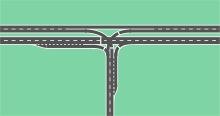
- Seagull intersection, continuous green T-intersection, turbo-T, or High-T intersection
- A type of three-way road intersection, usually used on high traffic volume roads and dual carriageways. In this type of intersection, one direction of traffic travels straight through without stopping while those wishing to turn onto the side road at the intersection simply bear into a separate lane, which forms one 'wing' of the seagull. Here, they meet the opposite carriageway and the side road. Traffic wishing to turn out of the side road, simply cross the intersecting carriageway and drive up the other 'wing' of the seagull, and merge onto the other carriageway.
- Sealed road
- A road on which the surface has been permanently sealed by the use of a pavement treatment, such as bitumen.
- Service area
See rest area
- Service road
See frontage road
- Sidewalk, footpath, footway, or pavement
- A path along the side of a road.
- Shoulder
- A reserved lane by the verge of a road or motorway.
- Single carriageway or undivided highway
- A road with one, two, or more lanes arranged within a roadway or carriageway with no physical separation of opposing flows of traffic.
- Single point urban interchange or SPUI
- A variant of the diamond interchange most often used in urban areas where conservation of space is necessitated.
- Sleeper lines
See rumble strips
- Slip road or ramp
- A connector road between the intersecting roads of an interchange.
- Slope
See grade
- Spaghetti Junction
- A nickname sometimes given to a complicated or massively intertwined road traffic interchange that resembles a plate of spaghetti. The term was originally used to refer to the Gravelly Hill Interchange on the M6 in Birmingham.[10]

- Special route
- A prefixed and/or suffixed numbered road in the United States that forms a loop or spur of a more dominant route of the same route number and system.
- Speed bump, speed hump, speed ramp, speed cushion, or speed table
- A family of traffic calming devices that use vertical deflection to slow motor-vehicle traffic in order to improve safety conditions.
- Speed limit
- The maximum (or minimum in some cases) speed at which road vehicles may travel legally on particular stretches of road.
- Spur route
- An highway that branches off of the mainline and goes to an area that is not served by the mainline highway.
- Stack interchange, butterfly junction, or directional interchange
- A free-flowing, grade-separated junction between two roads, where movements are handled by semi-directional flyovers or under ramps. Vehicles first exit the main carriageway, then complete the turn via a ramp that crosses both highways, eventually merging with the traffic from the opposite side of the interchange.
- State highway, state road, state route, provincial highway, provincial road, or provincial route
- A road numbered or maintained by a state or province.
- A road numbered or maintained by a national government, where "state" is used in its sense of a nation (for example, state highways in New Zealand).
- Straight-line diagram or strip map
- A diagram that describes a road and its features along a straight line.
- Stub ramp, stub street, stub-out, stub, or ski jump
See unused highway
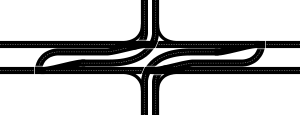
- Superstreet, restricted crossing U-turn (RCUT), J-turn, or Reduced Conflict Intersection
- An at-grade intersection where traffic on the minor road cannot go straight across. Traffic on the minor road wishing to turn left or continue straight must turn right onto the major road, then, a short distance away, use a U-turn (or crossover) lane in the median before either going straight or making a right turn when they intersect the other half of the minor road.
- Super two, super two-lane highway, or wide two lane
- A two-lane surface road built to highway standards, typically including partial control of access, occasional passing lanes and hard shoulders.
T
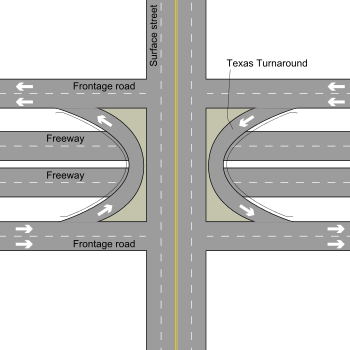
- Texas U-turn, Texas turnaround, or Loop Around
- A lane allowing cars traveling on one side of a one-way frontage road to U-turn onto the opposite frontage road (typically crossing over or under a freeway or expressway).
- Three-point turn or K-turn
- A method of turning a vehicle around (making a 180° turn) in close quarters, such as in the middle of a road at a point other than an intersection.
- Three-way junction, 3-way junction, 3-way intersection, Y junction, Y intersection, T junction, or T intersection
- a type of road intersection with three arms. A Y junction generally has 3 arms of equal size. A T junction also has 3 arms, but one of the arms is generally a minor road connecting to larger road.
- Ticket system or closed toll collection system
- A toll road where motorists pay a toll rate based on the distance traveled from their origin to their destination exit. Motorists take a ticket when entering the road and pay the toll and surrender the ticket upon exiting.
- Toll road, turnpike, or tollway
- A road for which a fee (or toll) is assessed for passage.
- Tourist road, tourist route, tourist drive, or theme route
See scenic route
- Traffic
- Pedestrians, ridden or herded animals, vehicles, streetcars, buses and other conveyances, either singly or together, that use roads for purposes of travel.
- Traffic circle
See roundabout
- Traffic island, painted island, or ghost island
- A solid or painted object in a road that channelises traffic.
- Traffic light
- Signaling devices positioned at road intersections, pedestrian crossings and other locations to control competing flows of traffic.
- Traffic sign or road sign
- A method of conveying information to people who are using a road. Depending on location, the main color of the sign can tell the motorist what type of information is presented on the sign.
- Travel plaza
See rest area
- Truck or lorry
- A vehicle designed to carry cargo.
- Truck arrester bed
- Truck driver, trucker or truckie, lorry driver, or driver
- A person who earns a living by driving a truck
- Truck route
- A bypass designed for heavy truck traffic.
- Turnaround
- A type of junction that allows traffic traveling in one direction on a road to efficiently make a U-turn typically without backing up or making dangerous maneuvers in the middle of the traffic stream.
- Turn off to stay on (TOTSO)
- When a motorist must exit a highway to continue traveling on the same numbered route.
- Turbo-T
- Two-lane expressway
- An expressway with only one lane in each direction, and usually no median barrier.
- Two-lane road
- A single carriageway with one lane for each direction.
U
- Undivided highway
- Unused highway, ski jump, stub ramp, stub street, stub-out, or stub
- A highway or highway ramp that was partially or fully constructed, but was unused or later closed.
- U-turn
- A 180° rotation to reverse the direction of travel so called because the maneuver looks like the letter U.
V
- Variable-message sign, dynamic message sign, or matrix sign
- A traffic sign that can display important messages about special events to motorists. Commute times, weather alerts, Amber alerts, and advanced notices of road construction or accidents are common messages.
- Vienna Convention signs
 Speed limit
Speed limit No parking
No parking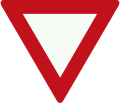 Yield (Give Way)
Yield (Give Way)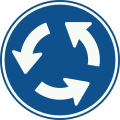 Round-about
Round-about
- Vienna Convention on Road Signs and Signals
- A multilateral treaty designed to increase road safety and aid international road traffic by standardizing the signing system for road traffic (road signs, traffic lights and road markings) in use internationally.
- Vienna Convention on Road Traffic
- An international treaty designed to facilitate international road traffic and to increase road safety by establishing standard traffic rules among the contracting parties.
W
- Weigh station
- A checkpoint along a highway to inspect vehicular weights. Usually, trucks and commercial vehicles are subject to the inspection.
- Wide two lane
See super two
- Wrong-way concurrency
- A concurrency between two roads with opposite signed directions, e.g. a westbound highway and an eastbound highway. Often, the physical roadbed is actually headed in a totally different cardinal direction.
X
- XDL

- Xing or x-ing
- An abbreviation for road crossing, primarily used in North America
Y
- Y junction or Y intersection
Z
- Zebra crossing
- A pedestrian crossing marked by alternating dark and light stripes, which typically gives extra rights of way to pedestrians.
See also
References
- ↑ Cooper, Scott (February 14, 2000). "Overview of UCSB's Relationship to the Goleta Old Town Revitalization Plan". University of California, Santa Barbara. Retrieved March 18, 2008.
[C]hanges to Highway 217 were now imminent, both because the state bill had been signed which would decommission Highway 217 and transfer its authority to Santa Barbara County—decommissioning of a road in this source broadly signifies the process of removal of state status and transfer to local authority control and management.
- ↑ "A Chronology of the Construction History of Route 66 in Oklahoma". Oklahoma Department of Transportation. Retrieved March 18, 2008.
- ↑ Edmonds, Leigh (1997). The Vital Link: A History of Main Roads Western Australia 1926–1996. Nedlands, Western Australia: University of Western Australia Press. p. 184. ISBN 1-875560-87-4.
- ↑ MRWA Waterways Section; BG&E Pty Ltd (April 24, 2006). "Floodway Design Guide" (PDF). Main Roads Western Australia. p. 4. Archived (PDF) from the original on April 15, 2015. Retrieved April 15, 2015. Additional archives: April 15, 2015.
- ↑ "Lane". Free Merriam-Webster Dictionary.
- ↑ "Section 1A.13: Definitions of Words and Phrases in This Manual". Manual on Uniform Traffic Control Devices.
Expressway—a divided highway with partial control of access. ... Freeway—a divided highway with full control of access.
- ↑ "parkway". Webster's Third New International Dictionary, Unabridged. Merriam-Webster. 2002. Retrieved April 14, 2007.
- ↑ Black, Henry Campbell (1910). "Right-of-way". A Law Dictionary Containing Definitions of the Terms and Phrases of American and English Jurisprudence, Ancient and Modern: and Including the Principal Terms of International, Constitutional, Ecclesiastical, and Commercial Law, and Medical Jurisprudence, with a Collection of Legal Maxims. West Publishing. p. 1040 – via Google Books.
- ↑ The New Shorter Oxford English Dictionary. Volume 2. Oxford: Clarendon Press. 1993. p. 2632.
- ↑ "Spaghetti junction". English Collins Dictionary. HarperCollins Publishers LLC. Retrieved May 13, 2013.
External links
| Wikimedia Commons has media related to road transport. |




